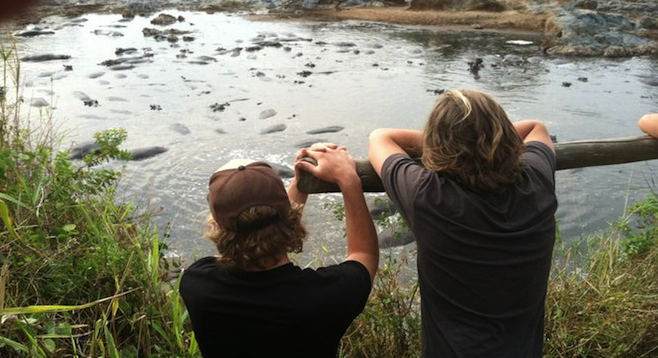 Facebook
Facebook
 X
X
 Instagram
Instagram
 TikTok
TikTok
 Youtube
Youtube

Even during the dry season, there is water in the Serengeti. One of the region's most notable watering holes is the hippo pool. Fed by the Seronera River, the site is located towards the northwest border of this Tanzanian national park and is most easily accessed via the Ikoma entrance.
When you step outside your Land Rover, the first thing that you notice is the odor. It is strong – unpleasantly so. The methane-laced air grows stronger and stronger as you near the water. Once the pool comes into view, it's quickly evident why the smell is so powerful.
The pond, which could more aptly be described as a mud hole, is home to over 100 hippos. It’s difficult to count them; they are either completed submerged or partially submerged. Those large herbivores not resting on the lakebed's bottom expose only the tops of their backs or the tops of their nostrils. They look like large gray stepping stones strewn across the waterway. The animals are in such close proximity to one another, it would be easy to walk across the pool without getting wet.
That is, of course, if hippos were gentle animals.
On the contrary: they’re one of the most aggressive mammals in Africa and are responsible for more deaths annually than any other four-legged animal on the continent. Due to their dangerous nature, it felt odd to be separated by only a one-rail wooden fence. And that was only in the viewing area!
If you have any thoughts about circumventing the lone obstruction to get a better view, they’re quickly dashed by the number of rather large crocodiles sunning themselves on the warm rocks. The reptiles’ natural skin blended in so well with their surroundings that it was difficult to see them even when they were pointed out.
So often the Serengeti is silent. The vast landscapes are disturbed by dust clouds of migrating animals, but rarely broken by sound. In an environment where I’d come to expect quiet, the hippos broke the stillness with constant snorting and fighting. Add in the expulsion of gas and dung and the pond was little more than a bubbling, dark, murky cauldron of filthy water.
Hippos are cantankerous and quick to fight. Their large mouths seemingly unhinge to expose dull but very large teeth. They bite at one another, bumping into others, causing a stir throughout the ranks. Slowly they resume their feeding and settle back down – only to have an attack break out minutes later in a different section of the pool.
All in all, the hippo pool is great theater. It’s a place where you’re assured to see large animals in their element. What first appears to be just a bunch of rocks in a dirty, stinky pool becomes an entertaining look into the social interaction of this amazing species.


Even during the dry season, there is water in the Serengeti. One of the region's most notable watering holes is the hippo pool. Fed by the Seronera River, the site is located towards the northwest border of this Tanzanian national park and is most easily accessed via the Ikoma entrance.
When you step outside your Land Rover, the first thing that you notice is the odor. It is strong – unpleasantly so. The methane-laced air grows stronger and stronger as you near the water. Once the pool comes into view, it's quickly evident why the smell is so powerful.
The pond, which could more aptly be described as a mud hole, is home to over 100 hippos. It’s difficult to count them; they are either completed submerged or partially submerged. Those large herbivores not resting on the lakebed's bottom expose only the tops of their backs or the tops of their nostrils. They look like large gray stepping stones strewn across the waterway. The animals are in such close proximity to one another, it would be easy to walk across the pool without getting wet.
That is, of course, if hippos were gentle animals.
On the contrary: they’re one of the most aggressive mammals in Africa and are responsible for more deaths annually than any other four-legged animal on the continent. Due to their dangerous nature, it felt odd to be separated by only a one-rail wooden fence. And that was only in the viewing area!
If you have any thoughts about circumventing the lone obstruction to get a better view, they’re quickly dashed by the number of rather large crocodiles sunning themselves on the warm rocks. The reptiles’ natural skin blended in so well with their surroundings that it was difficult to see them even when they were pointed out.
So often the Serengeti is silent. The vast landscapes are disturbed by dust clouds of migrating animals, but rarely broken by sound. In an environment where I’d come to expect quiet, the hippos broke the stillness with constant snorting and fighting. Add in the expulsion of gas and dung and the pond was little more than a bubbling, dark, murky cauldron of filthy water.
Hippos are cantankerous and quick to fight. Their large mouths seemingly unhinge to expose dull but very large teeth. They bite at one another, bumping into others, causing a stir throughout the ranks. Slowly they resume their feeding and settle back down – only to have an attack break out minutes later in a different section of the pool.
All in all, the hippo pool is great theater. It’s a place where you’re assured to see large animals in their element. What first appears to be just a bunch of rocks in a dirty, stinky pool becomes an entertaining look into the social interaction of this amazing species.
Comments